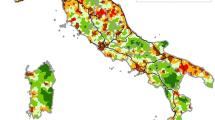Abstract
The “National Strategy for Internal Areas”, made by the Italian Government for the European Union Partnership Agreement 2014-2020, defines the territory of the Italian internal areas as a set of project-areas, local inter-municipal systems each with its own territorial identity defined by social, economic, geographic, demographic and environmental characteristics. In this sense, we can define “internal” those areas significantly distant from the centers of supply of essential services (education, health, and mobility), rich in environmental and cultural resources with highly diversified natural aspects. The objective of the work is to re-elaborate the existing mapping for the identification of the internal areas, made by the Italian Government, especially taking into account the demographic, economic, morphological profiles and essential services supply, through the use of fuzzy logic. Then, trying to deep explain possible planning strategies and policies for these relevant, sometimes abandoned and extremely diffuse territories.
The contribution is the result of joint reflections by the authors, with the following contributions attributed to S. Montrone (chapter 3), to P.Perchinunno (chapter 4), to F. Rotondo (chapter 2 and 5), to F. Selicato (chapter 1). The conclusions are the result of the common considerations of the authors.
Access this chapter
Tax calculation will be finalised at checkout
Purchases are for personal use only
Preview
Unable to display preview. Download preview PDF.
Similar content being viewed by others
References
Magnaghi, A.: The Urban Village: A Charter for Democracy and Local Self-sustainable Development. Zed Books, London and New York (2005)
Latouche, S.: De-growth, Inequality and Poverty. In: Ventura, P., Calderon, E., Tiboni, M. (eds.) Sustainable development Policies for Minor Deprived Urban Communities, pp. 71–79. McGraw-Hill, Milano (2011)
McCann, P., Rodríguez-Pose, A.: Why and when development policy should be place-based. In: OECD (ed.) OECD Regional Outlook 2011: Building Resilient Regions for Stronger Economies. OECD Publishing, Paris (2011)
Barca, F., McCann, P., Rodríguez-Pose, A.: The case for regional development intervention: place-based versus place-neutral approaches. Journal of Regional Science 52, 134–152 (2012)
Barca, F.: An agenda for a reformed cohesion policy. A place-based approach to meeting European Union challenges and expectations. Independent Report, prepared at the request of Danuta Hübner, Commissioner for Regional Policy (2009). http://www.europarl.europa.eu/meetdocs/2009_2014/documents/regi/dv/barca_report_/barca_report_en.pdf (visited February 26, 2015)
Zadeh, L.A.: Fuzzy sets. Information and Control 8(3), 338–353 (1965)
Dubois, D., Prade, H.: Fuzzy sets and systems. Academic Press, Boston, New York, London (1980)
Cheli, B., Lemmi, A.: A Totally Fuzzy and Relative Approach to the Multidimensional Analysis of Poverty. Economic Notes 24(1), 115–134 (1995)
Cerioli, A., Zani, S.: A fuzzy approach to the measurement of poverty. In: Dagum, C., Zenga, M. (eds.) Income and Wealth Distribution, Inequality and Poverty. Springer Verlag, Berlin (1990)
Montrone, S., Perchinunno, P., Rotondo, F., Torre, C.M., Di Giuro, A.: Identification of hot spots of social and housing difficulty in urban areas: scan statistic for housing market and urban planning policies. In: Murgante, B., Borruso, G., Lapucci, A. (eds.) Geocomputation and Urban Planning, Studies in Computational Intelligence, vol. 176, pp. 57–78. Springer Verlag, Heidelberg (2009)
Perchinunno, P., Rotondo, F., Torre, C.M.: A multivariate fuzzy analysis for the regeneration of urban poverty areas. In: Gervasi, O., Murgante, B., Laganà, A., Taniar, D., Mun, Y., Gavrilova, M.L. (eds.) ICCSA 2008, Part I. LNCS, vol. 5072, pp. 137–152. Springer, Heidelberg (2008)
Montrone, S., Bilancia, M., Perchinunno, P., Torre, C.M.: Scan statistics for the localization of hot spots of urban poverty. In: Conference Proceedings of the Regional Studies Association, Winter Conference, Londra, pp. 74–77 (November 28, 2008)
Magnaghi, A.: The apulian approach to landscape planning. Urbanistica n. 147 July September 2011, distribution by www.planum.net
Author information
Authors and Affiliations
Corresponding author
Editor information
Editors and Affiliations
Rights and permissions
Copyright information
© 2015 Springer International Publishing Switzerland
About this paper
Cite this paper
Montrone, S., Perchinunno, P., Rotondo, F., Selicato, F. (2015). Internal Areas Strategies: From Statistical Methods to Planning Policies. In: Gervasi, O., et al. Computational Science and Its Applications -- ICCSA 2015. ICCSA 2015. Lecture Notes in Computer Science(), vol 9157. Springer, Cham. https://doi.org/10.1007/978-3-319-21470-2_48
Download citation
DOI: https://doi.org/10.1007/978-3-319-21470-2_48
Published:
Publisher Name: Springer, Cham
Print ISBN: 978-3-319-21469-6
Online ISBN: 978-3-319-21470-2
eBook Packages: Computer ScienceComputer Science (R0)




